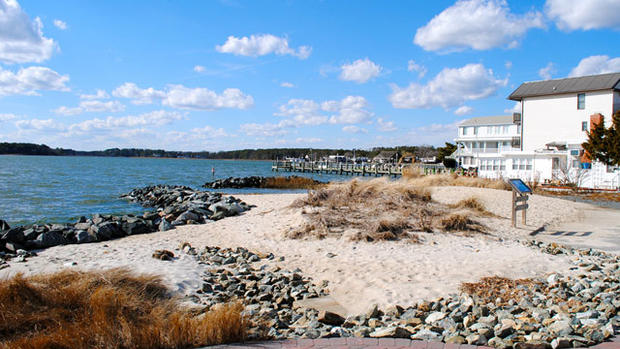Great white sharks coming closer to shore, people
Most of the country has experienced this week's dangerously high temperatures. But add one more hazard to the list this summer: shark sightings off our nation's beaches. Great whites have been spotted on both coasts and though nobody has been hurt, some encounters have been way too close for comfort.
A photo from Cape Cod captures every kayaker's worst fear. You see Walter Szulc looking back over his shoulder in panic. Ten feet away: the dorsal fin of a great white shark.
The same day, in Santa Cruz Calif. a great white took a bite out another kayak. The man inside was thrown into the water, but survived.
"We have sharks in the area at all times, so people need to be aware of that and just be careful," said Santa Cruz sheriff's deputy April Skalland.
They're just the latest in great white encounter, with hot temperatures bringing them earlier. But it's not the people they're after -- it's the exploding seal populations that have moved closer to shore.
Leading shark expert Ralph Collier says because seals are protected species and sharks -- their natural predator -- have been over-hunted, there's now about a quarter million grey seals on the Eastern Seaboard alone.
"The sharks go where the food is," he said. Breeding grounds like one in Cape Cod are a Vegas buffet for sharks.
On the West Coast 10 years ago there were 100,000 seals and sea lions, Collier said. Today there are over 400,000. The seal population has exploded for two reasons. For the last 40 years, they've been protected under the Marine Mammal Protection Act, meaning humans can't legally kill them. Meanwhile, their chief natural predator, sharks, have dwindled in numbers. That's largely due to the "finning," in which poachers cut off the sharks' dorsal fins -- a delicacy in some cultures -- leaving the rest of the animal to die. The combination of factors has let seals proliferate basically unchecked, expanding their habitat closer to shore and bringing the sharks left hunting them closer to humans.Collier said that, around people, great whites are more curious than aggressive, first investigating and then possibly taking "a nibble" to see whether the strange creature is anything of interest.
"White sharks are very curious apex predators, they will investigate objects at the surface," Collier said. "Sharks don't want to eat you. When they bite an individual it's usually a test -- it's an investigational encounter. ... The last thing they will do to find out what it is is to take a little nibble."
But a great white's nibble can be a deadly chomp for a human, which is why a San Diego area beach was shut down earlier this week.
"We were just looking at the shore and you could see the black fin. We saw at least one shark," one witness said. Her young son added that he thought it was two.
The last fatal shark attack in California was in Santa Barbara County in 2010 when a surfer was bitten. The last fatal shark attack off of Cape Cod was in 1936. Still, the sight of dorsal fins is sending a cold chill through what has been a hot summer for sharks.

